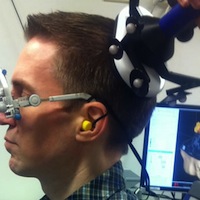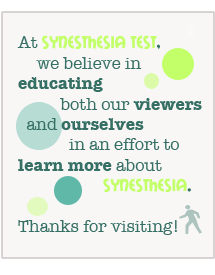Synesthesia Research – Interview w/ Kristian Marlow
 One of the great things about operating a blog on synesthesia is that – on a daily basis – you have the chance to live as a figment in the experiences of tremendously unique individuals. We’ve been privileged enough to attract a readership with a propensity to share, and we can’t express gratitude enough for your continued emails and comment contributions. Keep ’em coming! Aside from this common thread of “enjoying reading about others’ experiences,” we’ve had a number of users express interest in contributing to a synesthesia research study. While doing so physically (or in-person) might be preferred, it isn’t always feasible.
One of the great things about operating a blog on synesthesia is that – on a daily basis – you have the chance to live as a figment in the experiences of tremendously unique individuals. We’ve been privileged enough to attract a readership with a propensity to share, and we can’t express gratitude enough for your continued emails and comment contributions. Keep ’em coming! Aside from this common thread of “enjoying reading about others’ experiences,” we’ve had a number of users express interest in contributing to a synesthesia research study. While doing so physically (or in-person) might be preferred, it isn’t always feasible.
Contribute to Research Remotely
Lucky for all of you proximity-plagued folks, there are awesome opportunities for remote participation. One such opportunity – provided by the St. Louis Synesthesia Research Team (a lab directed by Dr. Berit Brogaard) – requires that you simply share your experiences with the research lab via email. An easy way to make an impact on research in the fields of neuroscience and synesthesia; all it takes to begin is one email.
Additionally, the St Louis-based lab (with collaborators around the globe) provides three different 10-question surveys that synesthetes can fill out online. The surveys are titled: Advanced Synesthesia, Migraine Aura and Synesthesia, and Special Talents. Check ’em out. Fill ’em out. Become a remote contributor!
An Interview with Kristian Marlow
Kristian Marlow, a graduate student at the University of Missouri in St. Louis and point-of-contact for the research lab, was kind enough to answer five questions that we posed about synesthesia and research. Frankly, I was blown away by his genuineness and thoroughness in his responses. I can’t urge you enough to read on.
1. Why did you become interested in researching synesthesia?
Synesthesia research is actually a pretty recent addition to my life. A few years ago I started to become very interested in the philosophy of perception. In this discipline, a lot of time is spent trying to find empirical evidence that supports or undermines certain theories of how the mind works. I learned that research on synesthesia offers particularly good empirical evidence in these types of disputes. As I studied synesthesia, I kept coming across questions I thought I could solve and since then have spend a lot of time constructing experiments to satisfy my interests. We have a few studies coming out this that that hopefully will address some of the big research questions.
2. What is the most interesting type of synesthesia you’ve encountered?
Not being a synesthete myself, I find all types of synesthesia fascinating, from the most common types like week-color and grapheme-color synesthesia to uncommon ones like motion-sound or person-taste synesthesia. Researchers like me find that no two synesthetes are exactly alike, which is interesting in itself. But some synesthetes have experiences that are incredibly unique. One of our case studies, Jason Padgett, has visual experiences of well-formed formulas. He’s spent a lot of time drawing these and actually sells the drawings as art. They really are beautiful. It turns out that some of these drawings approximate the same patterns that have only recently become producible on computers. A while back, we did functional MRIs of JP’s brain and found that visual imagery from well-formed formulas is processed in a completely different part of the brain than is normally associated with visual imagery. That unexpected result was really cool.
Another one of our case studies, Lidell Simpson, has always heard sounds associated with motion. He was born profoundly deaf and only started using hearing aids when he was diagnosed with mixed hearing loss at the age of 5. There is a debate among researchers whether the mind can generate true sounds without any auditory stimuli, but this seems to be a clear case where that has happened. He also hears a “ping” associated with everyone he knows. He has found friends in crowded spaces just by following the pings.
One other extraordinary case is that of Derek Amato. He hit his head on the bottom of a pool and awoke 3 days later able to compose classically structured music, even though he has no formal musical training. He constantly sees different colored blocks move across his visual field. He plays the piano by following these blocks with his fingers and has become pretty famous for this extraordinary talent.
3. Which special synesthete talents show up most frequently?
Synesthetes are most often found in the arts. Many famous painters and musician are synesthetes. We don’t really know why this is the case. These synesthetes often claim that their synesthesia helps them with their art. There have been a few cases where synesthesia can be very helpful for long-term memorization and mathematical calculation, but that appears to be rare.
4. Who is your favorite famous synesthete? Why?
I would be lying if I said I didn’t have a favorite famous synesthete. It’s Wassily Kandinsky, the Russian painter and art theorist. From the moment I first came across “Composition IV” as a freshman in high school, I knew that my goal was to have that painting hanging in front of my desk. I would later learn that his paintings sell for upwards of $20M. Historians believe that Kandinsky painted his synesthetic imagery. I was so pleased to learn this fact about such a brilliant artist. How fascinating is it that such beauty can emerge from synesthesia?
5. What is the best way to get involved in synesthesia research?
There is a lot of uncharted territory that researchers are starting to cover. Many synesthetes get involved because they are interested in learning more about why they have these experiences. But the truth is we aren’t even close to knowing why. The easiest way to get involved is through an academic institution with a lab already studying synesthesia, usually made up of philosophers or neuroscientists (although faculty from other disciplines study it as well).
Some labs are well-known for their work on their topic. These include the St. Louis Synesthesia Research Team at the University of Missouri-St. Louis and the Eagleman Laboratory at Baylor College of Medicine in Houston. But you don’t have to be at an academic institution to take part in research. There are many books on the subject (a list is available on our team’s blog) and there are events held through organizations such as the American Synesthesia Association. And, of course, our team is always looking for synesthetes to participate in studies.
Incredible stuff, right? I’d like to extend a personal thank you to Kristian (and his lab) for the contribution. And, in closing, I’ll encourage any synesthetes out there to head on over to the team’s website and (if you fancy so) to participate in their research. That’s all for now, though! Thanks for stopping back!
Have any thoughts on any of Kristian’s answers? Want to get involved in synesthesia research? Leave your comments and questions below! 🙂




